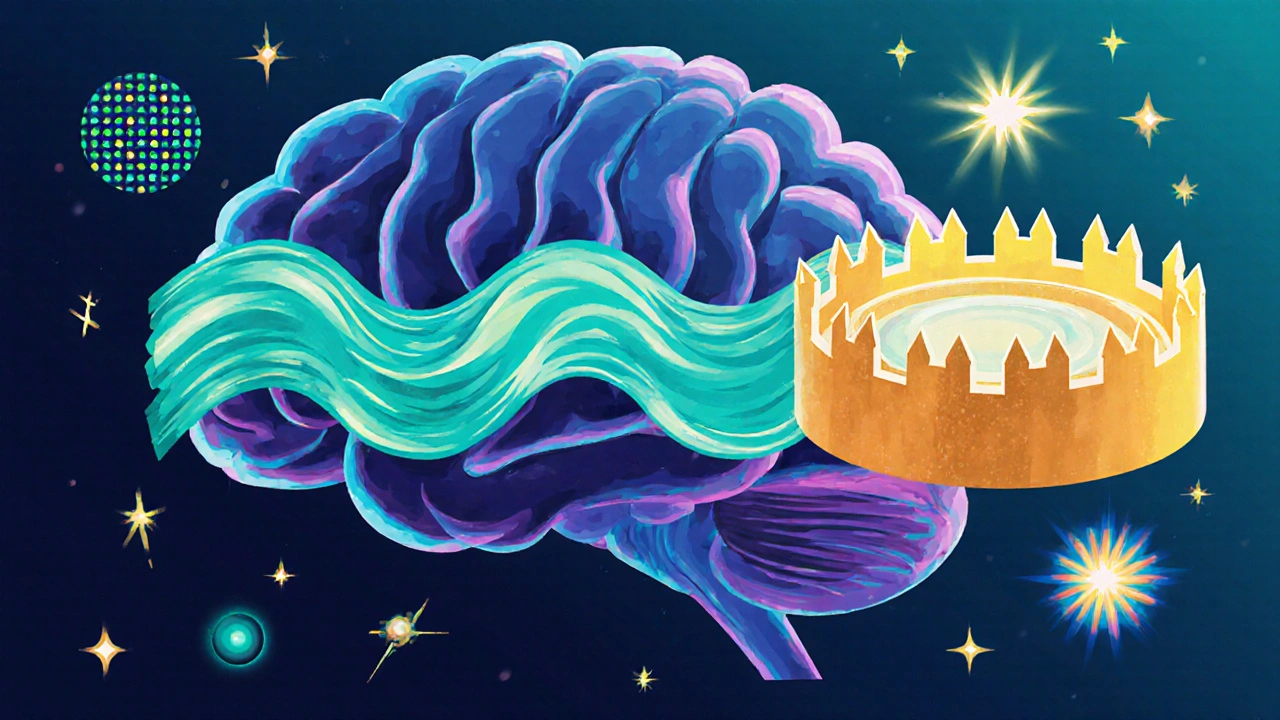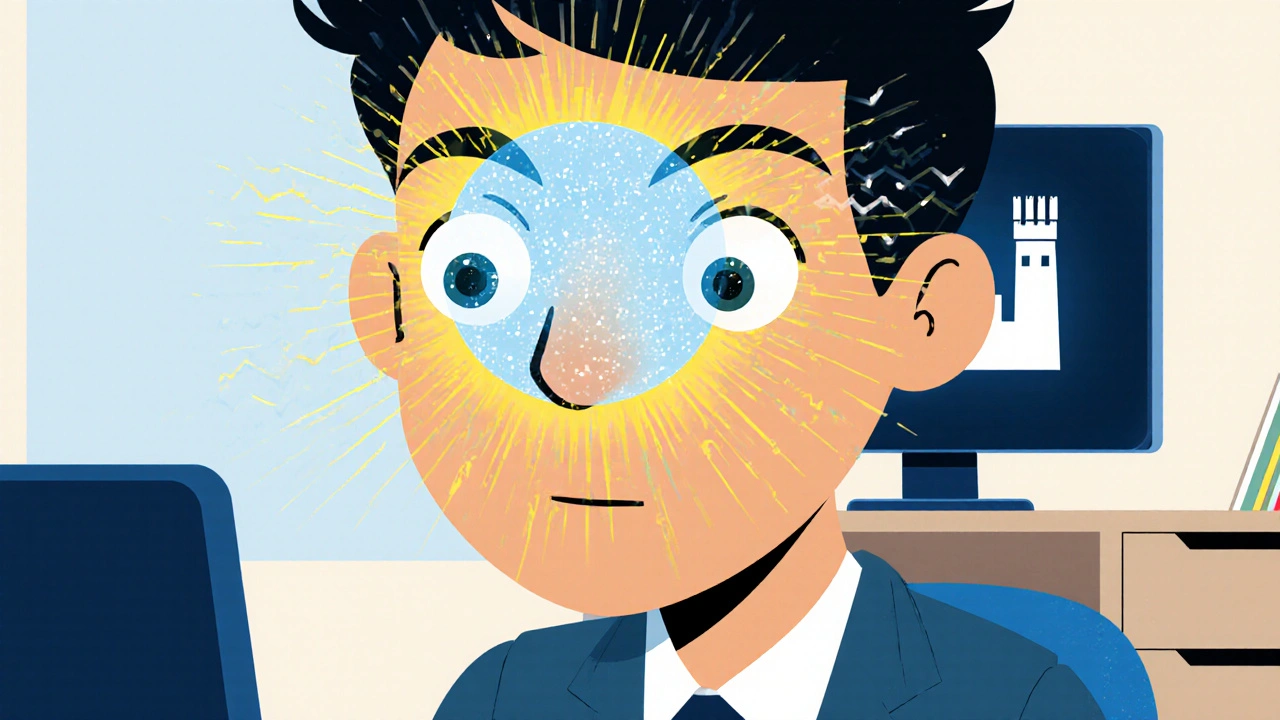Migraine Aura Treatment Timing Calculator
How Long Since Your Aura Started?
Taking medication within 15-30 minutes of aura onset maximizes effectiveness. This calculator helps determine if you're still in the optimal treatment window.
How to Use This Tool
- Step 1: When you first notice aura symptoms (flickering lights, blind spots, etc.), click "Start Aura Timer".
- Step 2: The timer will track how long since your aura began.
- Step 3: The alert messages will tell you if you're still in the optimal treatment window.
- Step 4: If you're within the window, take your prescribed migraine medication immediately.
Key Takeaways
- Migraine aura affects up to 30% of migraine sufferers and often starts with visual changes.
- Typical visual aura patterns include scintillating scotoma and fortification spectra.
- Recognizing aura helps differentiate migraine from serious eye conditions.
- Common triggers are stress, bright lights, and certain foods; managing them can reduce aura frequency.
- Acute treatments such as triptans work best when taken at aura onset.
What Is a Migraine Aura?
When you first hear the term migraine aura is a set of neurological symptoms that appear before or during a migraine attack, you might picture a headache and forget about the visual fireworks that often come first. In reality, the aura is a brain‑derived warning signal, lasting from a few minutes up to an hour, that can involve sight, sensation, speech, or even motor function. The most common form is visual, but non‑visual auras are equally real and need attention.
How the Visual System Gets Involved
The visual cortex, located at the back of the brain, is highly sensitive to sudden changes in blood flow and neuronal firing. During an aura, a wave of cortical spreading depression (CSD) travels across the cortex, temporarily silencing neurons. This electrical storm creates classic visual distortions:
- Scintillating scotoma is a flickering blind spot that expands outward like a growing circle.
- Fortification spectra are zig‑zag lines resembling castle walls that radiate from the blind spot.
- Geometric patterns, shimmering lights, or brief loss of vision can also appear.
These visual cues are not eye‑related; they stem from brain activity, which is why eye exams often come back normal.
Typical Timeline of a Migraine Attack
- Prodrome (hours‑days before): Mood changes, food cravings, or neck stiffness.
- Aura (5‑60 minutes): Visual disturbances, tingling, or speech difficulty.
- Headache phase (4‑72 hours): Throbbing pain, often one‑sided, with nausea, photophobia, and phonophobia.
- Post‑drome (hours): Fatigue, mild confusion, or feeling “drained.”
Understanding this sequence helps you act early-taking medication at aura onset can blunt the headache.

Common Triggers That Set Off an Aura
Not everyone reacts to the same triggers, but research shows a few culprits are frequent:
- Stress is a powerful trigger that can provoke cortical spreading depression.
- Bright or flickering lights (e.g., computer screens, strobe lights).
- Hormonal fluctuations, especially in women during menstrual cycles.
- Sleep disruption - both too little and oversleeping.
- Certain foods: aged cheese, processed meats, and excessive caffeine.
Keeping a headache diary lets you pinpoint which factors matter most for you.
When to Seek Medical Attention
Most migraine auras are benign, but some symptoms overlap with serious eye or neurological conditions. Contact a doctor-or head straight to an emergency department-if you notice:
- Sudden loss of vision in one eye that doesn’t improve.
- Persistent double vision or eye pain.
- Neurological signs such as weakness, numbness, or difficulty speaking.
- Aura lasting longer than an hour or changing pattern dramatically.
These signs could indicate retinal disease, stroke, or transient ischemic attack, which need urgent care.
Managing Aura: Lifestyle & Medication
Effective control combines trigger management and targeted drugs.
Lifestyle Strategies
- Maintain a regular sleep schedule-aim for 7‑8 hours.
- Stay hydrated; dehydration can lower the threshold for CSD.
- Use blue‑light filters on screens and wear polarized sunglasses outdoors.
- Practice stress‑relief techniques: progressive muscle relaxation, yoga, or short walks.
Acute Pharmacological Options
When aura appears, fast‑acting medication works best.
- Triptans are serotonin receptor agonists that constrict blood vessels and block pain pathways. They are most effective if taken within the first 15‑30 minutes of aura.
- Ergot derivatives (e.g., dihydroergotamine) are alternatives when triptans fail.
- Over‑the‑counter NSAIDs (ibuprofen, naproxen) can reduce inflammation if combined with a triptan.
Preventive Therapies
If you experience aura more than twice a month, preventive treatment may be worth considering.
- Beta‑blockers (propranolol) lower overall migraine frequency.
- Antiepileptic drugs such as topiramate have shown efficacy for visual aura.
- Newer CGRP monoclonal antibodies (erenumab is a monoclonal antibody that blocks the calcitonin‑gene‑related peptide receptor) reduce aura occurrence in many patients.
Discuss with a neurologist the best regimen for your pattern.

Comparing Common Aura Types
| Aura Type | Typical Duration | Most Common Symptom | Key Management Tip |
|---|---|---|---|
| Visual | 5‑60min | Scintillating scotoma / fortification spectra | Take triptan at first flicker |
| Somatosensory | 5‑30min | Tingling or numbness, often starting in the hand | Keep a diary to spot limb‑specific triggers |
| Speech / Language | 5‑15min | Word‑finding difficulty or slurred speech | Seek immediate medical evaluation if persistent |
| Motor | 5‑20min | Weakness on one side of the body | Urgent assessment-could mimic stroke |
Living With Migraine Aura
Many people fear their vision changes, worrying they’ll lose sight permanently. Reassuringly, a visual aura never causes lasting eye damage. Acceptance begins with education: knowing that the flickering lights are a brain signal, not an eye disease, reduces anxiety.
Support groups-online or local-offer a place to share trigger‑management tricks, medication experiences, and coping strategies. Employers can also help by allowing flexible work hours or dimmed lighting, which can minimise aura onset during the workday.
Frequently Asked Questions
Can I get a migraine aura without a headache?
Yes. About 10‑15% of migraine sufferers experience aura without ever developing the pain phase. These are called "silent migraines" and still benefit from early triptan use.
How long is it safe to wait before taking medication?
The earlier, the better. Taking a triptan within the first 15minutes of visual aura maximizes pain relief and can shorten the headache duration by up to 50%.
Do eye doctors treat migraine aura?
Eye specialists can rule out ocular disease, but migraine aura is managed primarily by neurologists or primary‑care physicians with a focus on preventive medication and lifestyle changes.
Can dietary changes reduce aura frequency?
For many, eliminating trigger foods like aged cheese, processed meats, and excessive caffeine lowers aura episodes. A 2023 diet‑study showed a 28% reduction in aura frequency after a 6‑week low‑tyramine diet.
Is it safe to drive during an aura?
No. Visual distortions can impair depth perception and reaction time. If you experience aura, pull over safely or wait until the symptoms subside before resuming driving.
Next Steps If You Suspect Migraine Aura
- Start a symptom diary: record date, time, aura description, triggers, and medications. \n
- Schedule an appointment with a neurologist to discuss preventive options.
- Implement at least two lifestyle changes-consistent sleep and screen filters are low‑effort wins.
- If aura lasts longer than an hour or you notice neurological changes, seek emergency care.
Understanding the link between your vision and migraine empowers you to act faster, reduce pain, and keep your life on track.


Comments (16)
Ashley Leonard October 15 2025
I’ve always been curious about how the visual aura works.
The way the brain’s cortical spreading depression creates those zig‑zag fortifications is fascinating.
It’s good to know the aura is harmless to the eyes, so we don’t panic when we see it.
Keeping a diary of triggers can really help pinpoint stress or screen time as culprits.
Thanks for the clear breakdown!
swapnil gedam October 16 2025
Totally agree, tracking triggers makes a world of difference.
It’s the first step to cutting down those scary flashes.
Michael Vincenzi October 17 2025
I’ve had the flickering lights before a migraine and found that taking a triptan right as they start cuts the headache in half.
Staying hydrated and using screen filters helped me drop the aura frequency.
Just a heads‑up for anyone trying to manage it.
Courage Nguluvhe October 18 2025
The cortical spreading depression (CSD) is essentially a massive wave of neuronal depolarization that propagates across the occipital cortex, disrupting visual processing.
This neurovascular event precipitates photophobia, scintillating scotoma, and fortification spectra, all of which are purely cortical phenomena, not ophthalmic.
Understanding the neurophysiological substrate allows clinicians to target the serotonergic pathway with triptans at the aura onset, thereby truncating the nociceptive cascade.
Moreover, modulation of the trigeminovascular system via CGRP antagonists has shown promise in prophylaxis.
In practice, aggressive trigger mitigation-especially low‑frequency light exposure and strict sleep hygiene-reduces CSD susceptibility.
Oliver Bishop October 19 2025
Sounds solid.
I also add a quick 10‑minute walk when the aura hits – it seems to reset my circulation.
Alissa DeRouchie October 20 2025
Oh great another post about migraines like we needed more! I swear my aura looks like a disco ball and nobody cares!
Emma Howard October 21 2025
Let’s get proactive! Keep that diary, set regular sleep, and try those blue‑light filters. You’ve got this!
dee gillette October 22 2025
While the overview is thorough, it overlooks the heterogeneity of aura phenotypes across different demographic cohorts.
For instance, younger patients often report somatosensory auras before visual disturbances, a pattern not emphasized here.
Additionally, the reliance on triptans may bias treatment toward acute relief, whereas emerging data suggest early use of CGRP monoclonal antibodies can attenuate the frequency of aura altogether.
A more nuanced discussion of individualized prophylaxis would strengthen the guide.
Jasin P. October 22 2025
Right, because everyone loves a lecture on migraines at 3 am.
Lily Đàn bà October 23 2025
Aura or apocalypse, I’m never sure!
Joseph O'Sullivan October 24 2025
Yo, just a heads up – if you’re driving, pull over. Those zig‑zag walls can make you miss a car.
Conor McCandless October 25 2025
Imagine sitting in a quiet coffee shop, the kettle humming, when suddenly your vision morphs into a medieval castle siege, walls flashing in jagged, neon hues that seem to pulse with your heartbeat.
The brain, in its mysterious brilliance, launches a wave of cortical spreading depression, a silent tsunami that silences neurons for fleeting minutes, yet leaves you feeling as if the world is being rewritten in real time.
These visual hallucinations, though harmless to the eye, are a stark reminder that the central nervous system governs perception more than the lenses ever could.
What’s fascinating is how the aura acts as a biomarker, a warning flag that the migraine train is about to roll in, giving you a narrow window to intervene with medication.
Studies have shown that taking triptans within the first fifteen minutes of the flicker can truncate the headache phase by up to fifty percent, a statistic that should galvanize anyone who endures those throbbing bouts.
However, not all patients respond to triptans; for them, newer CGRP monoclonal antibodies offer a prophylactic lifeline, dampening the frequency of both aura and pain.
Equally important is the lifestyle frontier: consistent sleep, hydration, and minimizing exposure to flickering LEDs can lower the threshold for that dreaded cortical wave.
Keeping a meticulous diary of triggers-be it stress, cheese, or a late-night binge‑watching session-transforms vague guesses into actionable data.
It’s also worth noting that aura can manifest without a subsequent headache, a “silent migraine” that still benefits from early triptan or NSAID administration.
For those who experience visual aura, driving is a non‑negotiable risk; pulling over or waiting for the visual distortions to fade is the safest course of action.
In the rare event that aura persists beyond an hour, or if it’s accompanied by weakness or speech difficulties, urgent medical evaluation is mandatory to rule out stroke or retinal pathology.
Neurologists can tailor a preventative regimen, perhaps combining beta‑blockers with topiramate, to keep that cortical wave at bay.
Ultimately, understanding that the flickering lights are a brain‑derived signal, not an eye disease, reduces anxiety and empowers patients to act decisively.
So next time the lights start dancing, reach for your medication, note the trigger, and remember you hold the reins of your own neuro‑navigation.
kat gee October 26 2025
Sure, just pop a pill and the universe will stop flashing.
Rene Lacey October 27 2025
When we contemplate the migraine aura, we are confronting the very ephemerality of perception itself.
The brain, as a quantum of consciousness, briefly rewires its visual cortex, offering a glimpse into the fragile scaffolding of reality.
Each scintillating scotoma is a reminder that our senses are not immutable windows but malleable filters shaped by neurochemical tides.
Thus, treating the aura is not merely a clinical endeavor but an invitation to observe the mind’s own fallibility.
By cataloguing triggers, we engage in a form of self‑scrying, peering into the causal circuitry that precipitates the storm.
The modern pharmacopeia-triptans, CGRP antagonists-serves as tools to modulate that storm, yet the ultimate mastery lies in harmonizing lifestyle rhythms.
In this dance between neuron and environment, balance begets resilience, and resilience quiets the cortical wave.
Embrace the aura as a teacher, not an enemy, and let its transient art guide you toward deeper self‑awareness.
johnson mose October 28 2025
Picture this: you’re in a coffee shop, the lights dim, and suddenly your vision turns into a medieval castle siege.
The walls flash in zig‑zag patterns, like neon battlements, and you feel a pressure building behind your eyes.
That’s an aura, the brain’s way of sounding the alarm before the migraine hits.
Grab your triptan as soon as you notice the first flicker, stay hydrated, and dim the lights around you.
It’s a small ritual that can keep the headache from storming in.
Ria M October 29 2025
Hey folks, let’s rally together and beat those migraines! 🎉 Keep a trigger journal, set a sleep schedule, and slap on those polarized shades when the sun is fierce.
When the visual fireworks start, don’t wait – pop that medication and own the moment.
Remember, you’re not alone in this; share your hacks, cheer each other on, and turn those auras into victories.